Tā moko
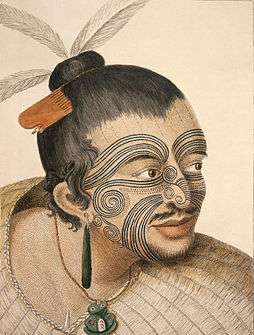
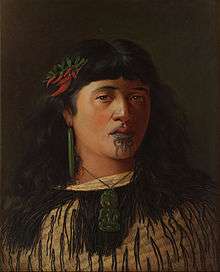
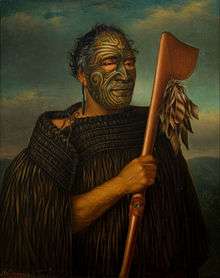
Tā moko is the permanent marking of the face and body as traditionally practised by Māori, the indigenous people of New Zealand. It is distinct from tattooing, in that the skin is carved by uhi[1] (chisels), not punctured. This leaves the skin with grooves rather than a smooth surface.
Captain James Cook wrote in 1769:
The marks in general are spirals drawn with great nicety and even elegance. One side corresponds with the other. The marks on the body resemble foliage in old chased ornaments, convolutions of filigree work, but in these they have such a luxury of forms that of a hundred which at first appeared exactly the same no two were formed alike on close examination.[2][3]
Tohunga-tā-moko (tattooists) were considered tapu, or inviolable and sacred.[4]
Background
Tattoo arts are common in the Eastern Polynesian homeland of Māori, and the traditional implements and methods employed were similar to those used in other parts of Polynesia.[5] In pre-European Māori culture, many if not most high-ranking persons received moko, and those who went without them were seen as persons of lower social status. Receiving moko constituted an important milestone between childhood and adulthood, and was accompanied by many rites and rituals. Apart from signalling status and rank, another reason for the practice in traditional times was to make a person more attractive to the opposite sex. Men generally received moko on their faces, buttocks (raperape) and thighs (puhoro). Women usually wore moko on their lips (kauwae) and chins. Other parts of the body known to have moko include women's foreheads, buttocks, thighs, necks and backs and men's backs, stomachs, and calves.
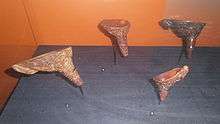
Instruments used
Originally tohunga-tā-moko (moko specialists) used a range of uhi (chisels) made from albatross bone which were hafted onto a handle, and struck with a mallet.[6] The pigments were made from the awheto for the body colour, and ngarehu (burnt timbers) for the blacker face colour. The soot from burnt kauri gum was also mixed with fat to make pigment.[7] The pigment was stored in ornate vessels named oko, which were often buried when not in use. The oko were handed on to successive generations. A kōrere (feeding funnel) is believed to have been used to feed men whose mouths had become swollen from receiving tā moko.[8]
Men were predominantly the tā moko specialists, although King records a number of women during the early 20th century who also took up the practice. There is also a remarkable account of a woman prisoner-of-war in the 1830s who was seen putting moko on the entire back of the wife of a chief.
Changes
The pākehā practice of collecting and trading mokomokai (tattooed heads) changed the dynamic of tā moko in the early colonial period. King (see below) talks about changes which evolved in the late 19th century when needles came to replace the uhi as the main tools. This was a quicker method, less prone to possible health risks, but the feel of the tā moko changed to smooth. Tā moko on men stopped around the 1860s in line with changing fashion and acceptance by Pākehā.
Women continued receiving moko through the early 20th century,[9] and the historian Michael King in the early 1970s interviewing over 70 elderly women who would have been given the moko before the 1907 Tohunga Suppression Act.[10][11] Women were traditionally only tattooed on their lips, around the chin, and sometimes the nostrils.[12][13]
Tā moko today
Since 1990 there has been a resurgence in the practice of tā moko for both men and women, as a sign of cultural identity and a reflection of the general revival of the language and culture. Most tā moko applied today is done using a tattoo machine, but there has also been a revival of the use of uhi (chisels).[14] Women too have become more involved as practitioners, such as Christine Harvey of the Chathams, Henriata Nicholas in Rotorua and Julie Kipa in Whakatane.
Te Uhi a Mataora was established in 2000 "to preserve, enhance, and develop tā moko as a living art form".[15]
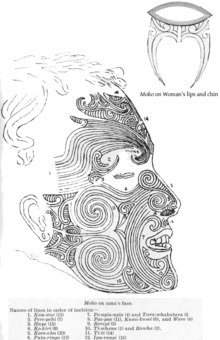 Māori Moko in 1908
Māori Moko in 1908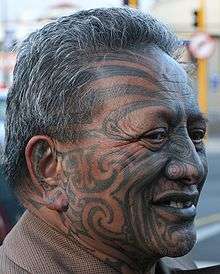
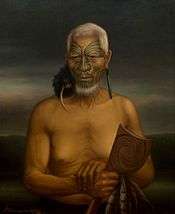 Tukukino Te Ahiātaewa (Ngāti Tamaterā)
Tukukino Te Ahiātaewa (Ngāti Tamaterā)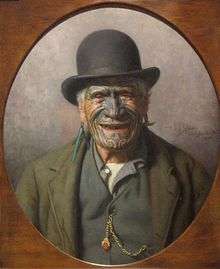 Te Aho-o-te-rangi Wharepu (Ngāti Mahuta)
Te Aho-o-te-rangi Wharepu (Ngāti Mahuta)
Use by non-Māori
Europeans were aware of tā moko from at the time of the first voyage of James Cook, and early Māori visitors to Europe, such as Moehanga in 1805,[16] then Hongi Hika in 1820 and Te Pēhi Kupe in 1826,[17] all had full-face moko, as did several "Pākehā Māori" such as Barnet Burns. However, until relatively recently the art had little global impact.
Appropriation of tā moko by non-Māori is deemed offensive,[18][19] and high-profile uses of Māori designs by Robbie Williams, Ben Harper and a 2007 Jean-Paul Gaultier fashion show were controversial.[20][21][22][23]
To reconcile the demand for Māori designs in a culturally sensitive way, the Te Uhi a Mataora group promotes the use of the term kirituhi,[24] which has now gained wide acceptance:[25][26][27][28]
...Kirituhi translates literally to mean—"drawn skin." As opposed to Moko which requires a process of consents, genealogy and historical information, Kirituhi is merely a design with a Maori flavour that can be applied anywhere, for any reason and on anyone...[24]
Gallery
- Tā moko
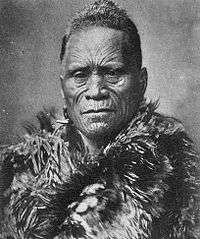
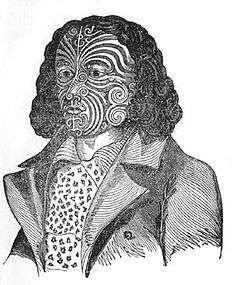
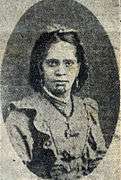
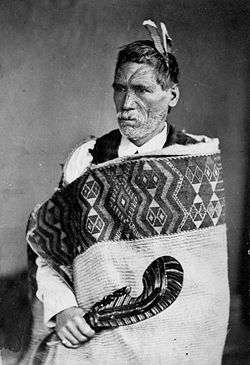
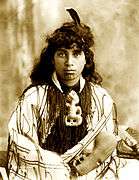 Guide Susan
Guide Susan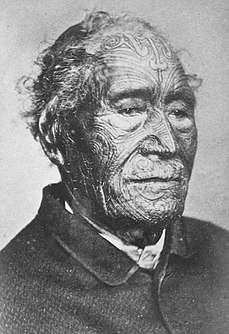
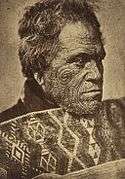 Tomika Te Mutu, (Ngāi Te Rangi)
Tomika Te Mutu, (Ngāi Te Rangi)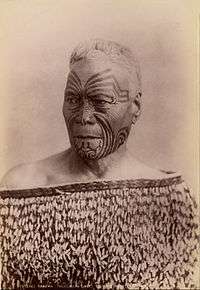
_-_Mrs_Rabone_-_Google_Art_Project.jpg) Mrs. Rabone, 1871
Mrs. Rabone, 1871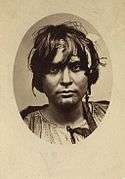 Hariota Hull
Hariota Hull
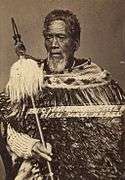
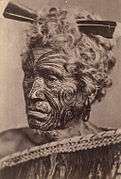
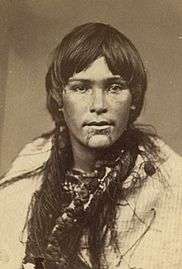

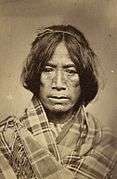
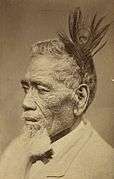
See also
References
- ↑ "Fig. 46.—Uhi, or chisels in the British Museum (actual size). Presented by Sir George Grey, K. C. B., &c". Retrieved 28 August 2015.
- ↑ Major-General Robley (1896). "Moko and Mokamokai — Chapter I — How Moko First Became Knows to Europeans". Moko; or Maori Tattooing. Chapman and Hall Limited. p. 5. Retrieved 2009-09-26.
- ↑ "Tattoo History Museum". vanishingtattoo.com. Retrieved 2009-08-24.
- ↑ "The Māori - The Tattoo (Ta Moko)".
- ↑ Hīroa 1951, p. 296
- ↑ Best, Eldson (1904). "The Uhi-Maori, or Native Tattooing Instruments". The Journal of the Polynesian Society. 13 (3): 166–72.
- ↑ "Kauri gum". Te Ara: The Encyclopedia of New Zealand. Retrieved 28 August 2015.
- ↑ "Korere - Tasman District". Landcare Research - Manaaki Whenua. Retrieved 21 March 2014.
- ↑ "A Relic of Barbarism". Wanganui Herald. 1904.
- ↑ King, Michael (July 1973). "Moko". Te Ao Hou The Māori Magazine.
- ↑ Smale, Aaron. "Ta Moko". New Zealand Geographic. Retrieved 4 May 2017.
- ↑ "Is Permanent Makeup Worth It?". Pinky Cloud. Archived from the original on 5 August 2015. Retrieved 16 February 2016.
- ↑ "History of Tattoos". TheTattooCollection.com. Retrieved 28 August 2015.
- ↑ "Revival of Moko". New Zealand Herald. 29 December 2007.
- ↑ "Te Uhi a Mataora". Toi Māori Aotearoa. Toi Māori Aotearoa. Archived from the original on 7 April 2017. Retrieved 3 May 2017.
- ↑ "...the first Maori who reached England...had a well tattooed face..."
- ↑ "Fig. 10.—Tattooing on the face of Te Pehi Kupe, drawn by himself". Retrieved 28 August 2015.
- ↑ "Moko".
- ↑ "Kirituhi - Moko Inspired".
- ↑ Kassem, Mia (March 2003). "Contemporary Manifestations of the traditional Ta Moko". NZArtMonthly. Archived from the original on 2011-02-24.
- ↑ "Cheeky French steal moko". Stuff.co.nz. 13 September 2007. Retrieved 16 November 2011.
- ↑ "Sharples: Protected Objects Third Reading Speech". Scoop. Retrieved 28 August 2015.
- ↑ "Why Most People Shouldn't Get Ta Moko Maori Tattoos". About.com Style. Retrieved 2017-05-03.
- 1 2 "Ta Moko - A History On Skin" (Press release). Christchurch Arts Festival 2005. 13 July 2005. Retrieved 3 May 2017 – via Scoop Independent News.
- ↑ "Moko 'exploitation' causes concern". The New Zealand Herald. NZPA. 3 November 2003. Retrieved 16 November 2011.
- ↑ Ihaka, James (27 March 2009). "Ta Moko making its mark on Maori". The New Zealand Herald. Retrieved 16 November 2011.
- ↑ "Myth and the moko". Waikato Times. Retrieved 16 November 2011.
- ↑ Cheseman, Janelle (15 March 2014). "The resurrection of tā moko raises questions for Maori". Newswire. Retrieved 3 May 2017.
Sources
- Hīroa, Te Rangi (1951). The Coming of the Maori. Wellington: Whitcombe & Tombs.
- Jahnke, R. and H. T., "The politics of Māori image and design", Pukenga Korero (Raumati (Summer) 2003), vol. 7, no. 1, pp. 5–31.
- King, M., and Friedlander, M., (1992). Moko: Māori Tattooing in the 20th Century. (2nd ed.) Auckland: David Bateman. ISBN 1-86953-088-8
- Nikora, L. W., Rua, M., and Te Awekotuku, Ng., "Wearing Moko: Māori Facial Marking in Today's World", in Thomas, N., Cole, A., and Douglas, B. (eds.), Tattoo. Bodies, Art and Exchange in the Pacific and the West, London: Reacktion Books, pp. 191–204.
- Robley, Maj-Gen H. G., (1896). Moko, or Maori Tattooing. digital edition from New Zealand Electronic Text Centre
- Te Awekotuku, Ngahuia, "Tā Moko: Māori Tattoo", in Goldie, (1997) exhibition catalogue, Auckland: Auckland City Art Gallery and David Bateman, pp. 108–114.
- Te Awekotuku, Ngahuia, "More than Skin Deep", in Barkan, E. and Bush, R. (eds.), Claiming the Stone: Naming the Bones: Cultural Property and the Negotiation of National and Ethnic Identity (2002) Los Angeles: Getty Press, pp. 243–254.
External links
| Wikimedia Commons has media related to Tā moko. |
- Museum of New Zealand Te Papa Tongarewa Online Resources on Moko
- Images relating to moko from the collection of the Museum of New Zealand Te Papa Tongarewa
- New Zealand Electronic Text Centre collection on Ta Moko, mokamokai, Horatio Robley and his art. A bibliography provides further links to other online resources.
- The rise of the Maori tribal tattoo, BBC News Magazine, 21 September 2012, Ngahuia Te Awekotuku, University of Waikato, New Zealand